Submitted:
24 October 2023
Posted:
26 October 2023
You are already at the latest version
Abstract
Keywords:
1. Introduction
1.1. State-of-the-art in coronal science
1.2. Observing the inner solar corona
1.3. Solar corona polarimetry
1.4. Scientific goals of the CMAG mission
- What is the structure of the inner coronal magnetic field? Understanding the magnetic field’s structuring in coronal loops and streamers and its evolution and relationship with photospheric fields is crucial. CMAG’s high spatial resolution (2.5 arcsec) and cadence (≈ 1 min) will determine the strength and direction of the vector magnetic field from close to the surface to the higher layers for providing an empirical basis that help validate and refine current extrapolations and improve coronal magnetic models.
- What is the coronal origin of the solar wind? The solar wind has distinct components: slow and fast, related to coronal streamers, coronal hole boundaries, and the solar network. CMAG will investigate the magnetic connection between coronal holes, streamers, and the solar wind, aiding to understand how the solar wind propagates through the heliosphere and its relationship with coronal waves.
- How are flares and CMEs generated? Flares and CMEs are phenomena with different effects on the heliosphere and the Earth’s environment. CMAG will reveal the inner corona’s internal structure and evolution and follow the magnetic field vector during the CME onset and the generation of associated waves. At a resolution of 2.5 arcseconds, it could also provide a glimpse of the evolution of the magnetic field structure at the reconnection sites.
- What is the origin of solar coronal heating? Measurements of magnetic field strength will provide a quantitative basis for assessing the origin of non-thermal heat observed in the Sun’s inner coronal layers.
- What is the role of the inner corona in space weather? CMAG’s measurements of inner coronal magnetic fields at L5, provided in almost real-time, will greatly enhance space weather nowcasting and forecasting capabilities, crucial for predicting radiation and energetic particle impacts on Earth as a consequence of flares and CMEs.
1.5. Top science requirements
| Spatial resolution | 2.5 arcsec at 750 nm |
| Aperture | 10 cm |
| Cadence | ≈ 1 min for S/N = 1000 in Stokes Q, U, and V |
| Field of view (FoV) | ≈ 2400" ( = 2.5 R⊙) |
| Targets spectral lines | Fe XIV 530 nm ; Fe XI 789 nm ; Fe XIII 1074 nm |
| Spectral resolution | 20 pm ; 30 pm ; 40 pm |
| Maximum spectral shift over the FoV | 25 pm ; 30 pm ; 50 pm |
| Detector dimensions | 4 k×4 k pixels |
| Etalon max. incidence angle 1 | |
| Etalon diameter | ≈ 60 mm |
| Polarization modulator interm. image diameter | ≈ 55 mm |
| dimensions | |
| stray-light requirements | @ 1.02 R⊙ |
2. Mission concept
2.1. Mission profile
2.2. Mission operations baseline and spacecraft concept
2.3. Payload concept design
2.4. CMAG data products
3. A mission opportunity
Funding
Acknowledgments
Conflicts of Interest
Abbreviations
| CMAG | Coronal Magnetograph |
| ESA | European Space Agency |
| CME | Coronal Mass Ejection |
| MHD | Magnetohydrodynamic |
| LASCO | Large Angle and Spectrometic Coronagraph |
| UVCS | Ultraviolet Coronagraph Spectrometer |
| SOHO | Solar and Heliospheric Observatory |
| STEREO | Solar TErrestrial RElations Observatory |
| SECCHI | Sun-Earth Connection Coronal and Heliospheric Investigation |
| METIS | the multi-wavelength coronagraph for the Solar Orbiter mission |
| SoloHI | Solar Orbiter Heliospheric Imager |
| ASPIICS | Association of Spacecraft for Polarimetric and Imaging Investigation of the Corona of the Sun |
| CRYO-NIRSP | Cryogenic Near-IR Spectro-Polarimeter |
| DKIST | Daniel K. Inouye Solar Telescope |
| SPARK | Solar Particle Acceleration Radiation and Kinetics |
| PDE | Performance Drift Error |
| COSMO | COronal Solar Magnetism Observatory |
| NASA | National Aeronautics and Space Administration |
| PUNCH | Polarimeter to Unify the Corona and Heliosphere |
| AOCS | Attitude and Orbit Control Subsystem |
| PHI | Polarimetric and Helioseismic Imager |
| TuMAG | Tunable Magnetograph |
Notes
- 1
- Predictive Science Inc. https://www.predsci.com/portal/home.php
| 1 | This assumes a mission to L5 and a certain solid fuel capacity that may vary. |
References
- Antonucci, E., Romoli, M., Andretta, V., et al. 2020, 642, A10. [CrossRef]
- Aschwanden, M. J. 2005, Physics of the Solar Corona. An Introduction with Problems and Solutions (2nd edition), by M.J. Aschwanden. 892 pages. ISBN 3-540-30765-6, Library of Congress Control Number: 2005937065. Praxis Publishing Ltd., Chichester, UK; Springer, New York, Berlin, 2005.
- Bout, M., Lamy, P., Maucherat, A., et al. 2000, 39, 3955. [CrossRef]
- Brooks, D. H., Warren, H. P., & Landi, E. 2021, 915, L24. [CrossRef]
- Brueckner, G. E., Howard, R. A., Koomen, M. J., et al. 1995, 162, 357. [CrossRef]
- Casini, R., White, S. M., & Judge, P. G. 2017,210, 145. [CrossRef]
- Culhane, J. L., Harra, L. K., James, A. M., et al. 2007, 243, 19. [CrossRef]
- Deforest, C., Killough, R., Gibson, S., et al. 2022, 2022 IEEE Aerospace Conference, 11. [CrossRef]
- Del Toro Iniesta, J. C., Orozco Suárez, D., Álvarez-Herrero, A. et al. 2024,in preparation.
- Domingo, V., Fleck, B., & Poland, A. I. 1994, 70, 7. [CrossRef]
- Erdélyi, R. & Fedun, V. 2007, Science, 318, 1572. [CrossRef]
- Fehlmann, A., Kuhn, J. R., Schad, T. A., et al. 2023, 298, 5. [CrossRef]
- Galano, D., Bemporad, A., Buckley, S., et al. 2018, 10698, 106982Y. [CrossRef]
- Howard, R. A., Moses, J. D., Vourlidas, A., et al. 2008, 136, 67. [CrossRef]
- Howard, R. A., Vourlidas, A., Colaninno, R. C., et al. 2020, 642, A13. [CrossRef]
- James, A. W., Williams, D. R., & O’Kane, J. 2022, 665, A37. [CrossRef]
- Judge, P. G. 1998, 500, 1009. [CrossRef]
- Judge, P. G., Casini, R., Tomczyk, S., et al. 2001, Technical Report, PB2002-102493; NCAR/TN-466-STR, 02.
- Judge, P. G. & Casini, R. 2001, Advanced Solar Polarimetry – Theory, Observation, and Instrumentation, 236, 503.
- Judge, P. G., Hutton, R., Li, W., et al. 2016, 833, 185. [CrossRef]
- Kohl, J. L., Esser, R., Gardner, L. D., et al. 1995, 162, 313. [CrossRef]
- Kosugi, T., Matsuzaki, K., Sakao, T., et al. 2007, 243, 3. [CrossRef]
- Kuridze, D., Mathioudakis, M., Morgan, H., et al. 2019, 874, 126. [CrossRef]
- Landi Degl’Innocenti, E. & Landolfi, M. 2004, Polarization in Spectral Lines. By Egidio Landi Degl’innocenti and Marco Landolfi, University of Fierenze, Firenze, Italy; Arcetri Observatory, Firenze, Italy. ASTROPHYSICS AND SPACE LIBERARY Volume 307 Kluwer Academic Publishers, Dordrecht. [CrossRef]
- Li, W., Grumer, J., Yang, Y., et al. 2015, 807, 69. [CrossRef]
- Li, W., Yang, Y., Tu, B., et al. 2016, 826, 219. [CrossRef]
- Lin, H., Kuhn, J. R., & Coulter, R. 2004,613, L177. [CrossRef]
- Martinez Pillet, V., Tritschler, A., Harra, L., et al. 2020, arXiv:2004.08632. [CrossRef]
- Mathioudakis, M., Jess, D. B., & Erdélyi, R. 2013, 175, 1. [CrossRef]
- Müller, D., St. Cyr, O. C., Zouganelis, I., et al. 2020, 642, A1. [CrossRef]
- Peter, H., Abbo, L., Andretta, V., et al. 2012, Experimental Astronomy, 33, 271. [CrossRef]
- Peter, H., Ballester, E. A., Andretta, V., et al. 2022, Experimental Astronomy, 54, 185. [CrossRef]
- Raouafi, N. E., Matteini, L., Squire, J., et al. 2023, 219, 8. [CrossRef]
- Reale, F. 2014, Living Reviews in Solar Physics, 11, 4. [CrossRef]
- Hamish A. S. Reid, et al. 2024, The Solar Particle Acceleration Radiation and Kinetics (SPARK) mission concept, MDPI, same edition.
- Rimmele, T. R., Warner, M., Keil, S. L., et al. 2020, 295, 172. [CrossRef]
- Rougeot, R., Flamary, R., Galano, D., et al. 2017, 599, A2. [CrossRef]
- Schad, T. & Dima, G. 2020, 295, 98. [CrossRef]
- Solanki, S. K. et al. 2024, in preparation.
- Solanki, S. K., del Toro Iniesta, J. C., Woch, J., et al. 2020, 642, A11. [CrossRef]
- Staub, J., Fernandez-Rico, G., Gandorfer, A., et al. 2020, Journal of Space Weather and Space Climate, 10, 54. [CrossRef]
- Temmer, M. 2021, Living Reviews in Solar Physics, 18, 4. [CrossRef]
- Tomczyk, S., Card, G. L., Darnell, T., et al. 2008, 247, 411. [CrossRef]
- Tomczyk, S. & Landi, E. 2019, Solar Heliospheric and INterplanetary Environment (SHINE 2019).
- Tomczyk, S., Burkepile, J., Casini, R., et al. 2023. [CrossRef]
- Trujillo Bueno, J. 2001, Advanced Solar Polarimetry – Theory, Observation, and Instrumentation, 236, 161. [CrossRef]
- Trujillo Bueno, J. & del Pino Alemán, T. 2022, 60, 415. [CrossRef]
- Computation of the Thomson scattering of the K-Corona. Available online: https://github.com/aliciavr/thomsonpy.
- Vourlidas, A., Howard, R. A., Plunkett, S. P., et al. 2016, 204, 83. [CrossRef]
- Yang, Z., Bethge, C., Tian, H., et al. 2020, Science, 369, 694. [CrossRef]
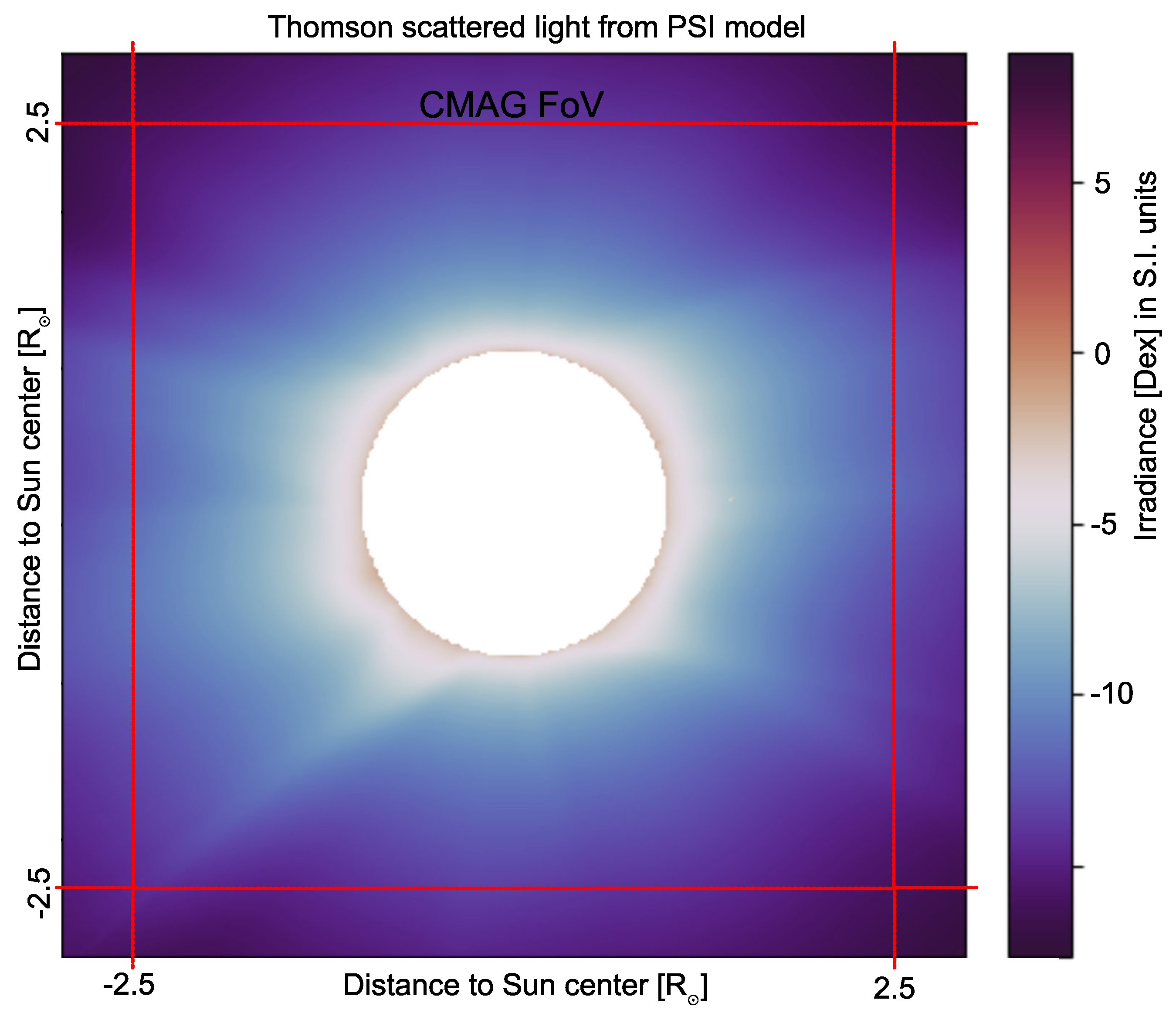
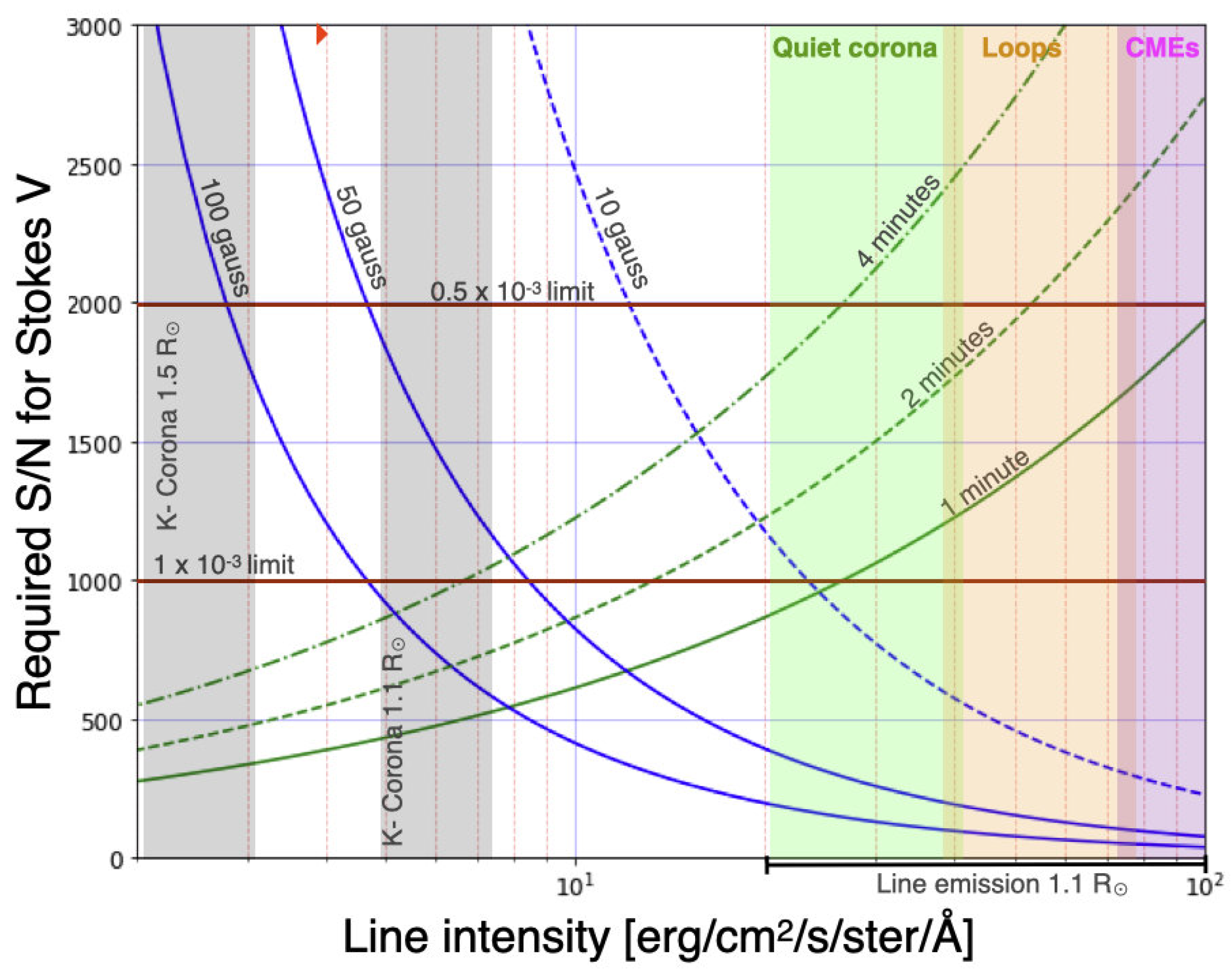
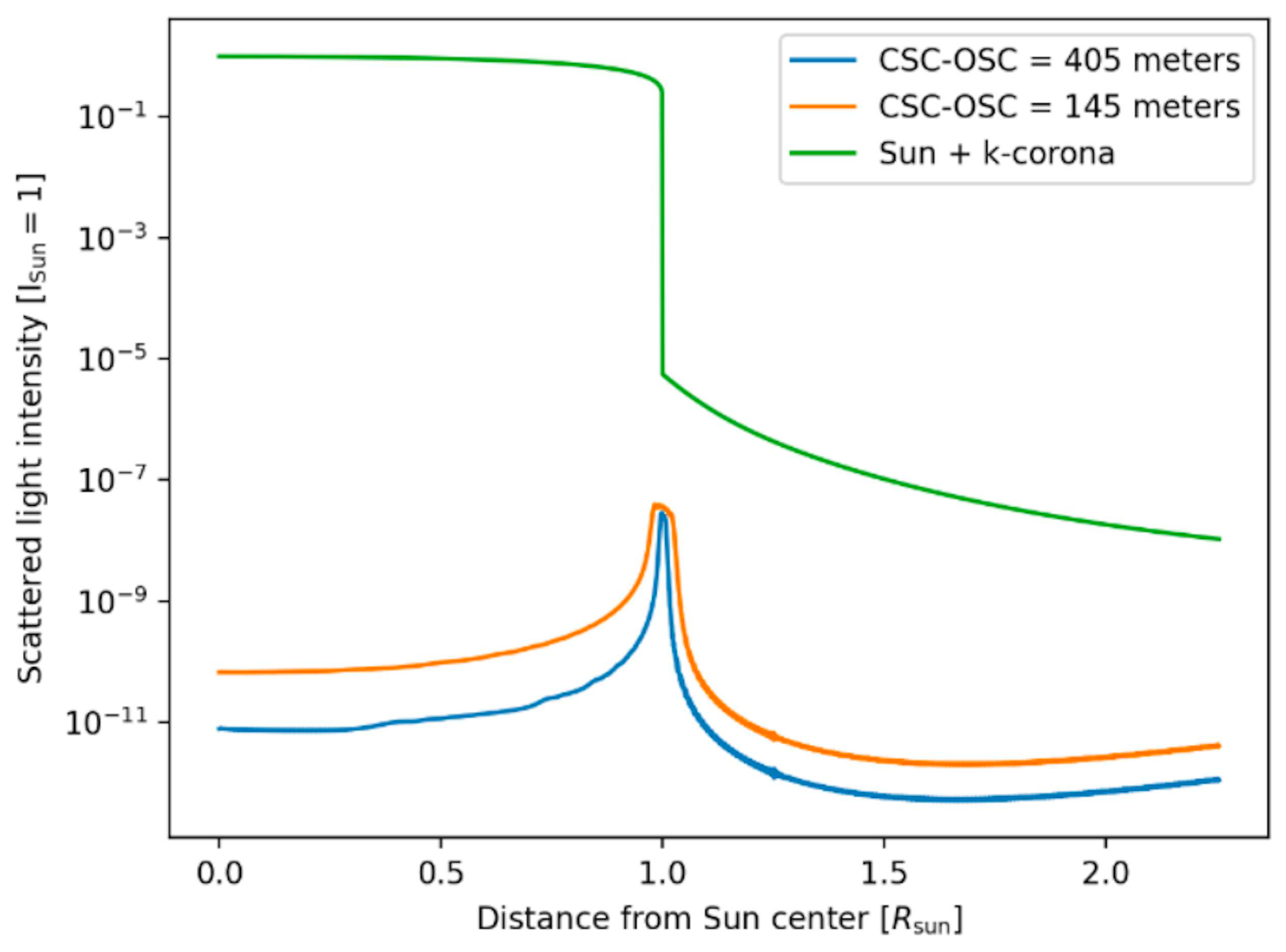
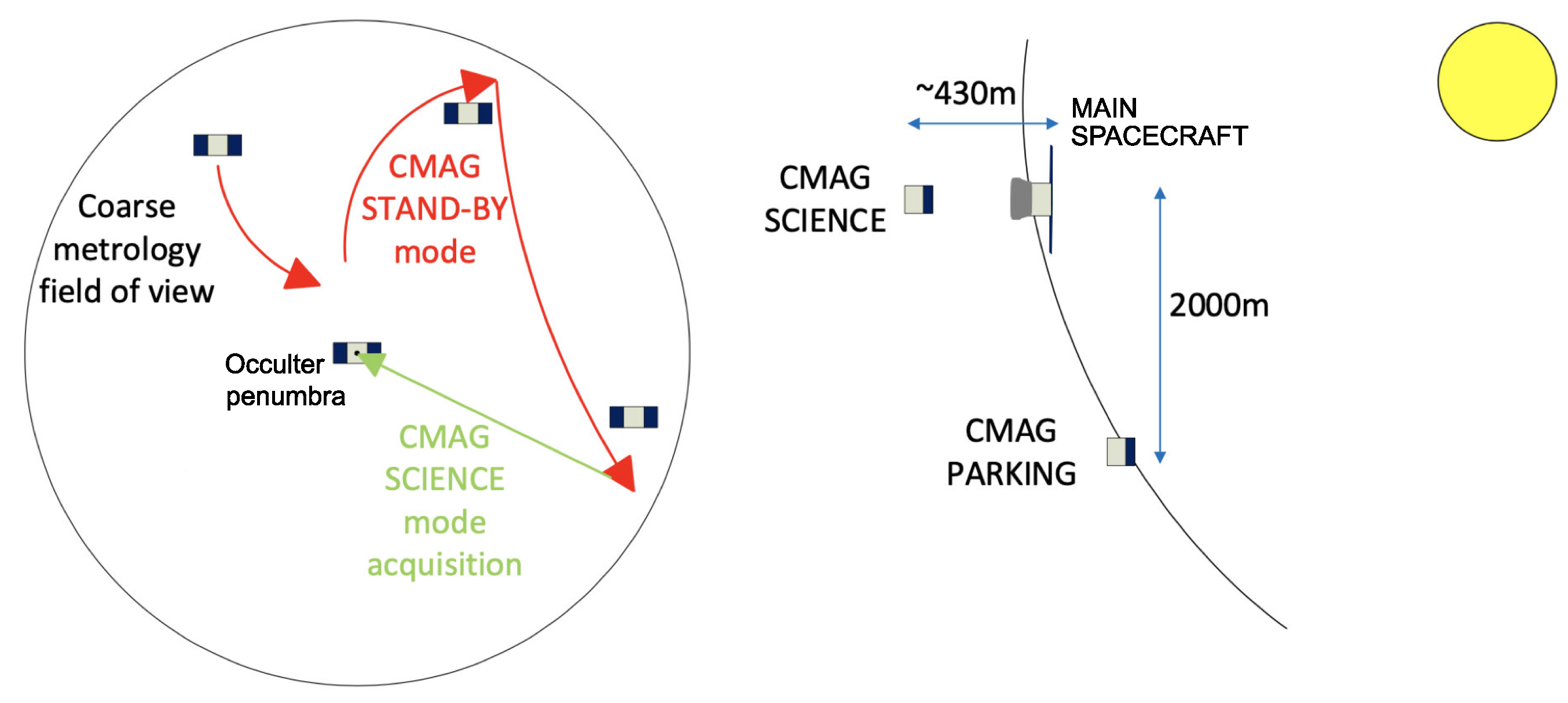
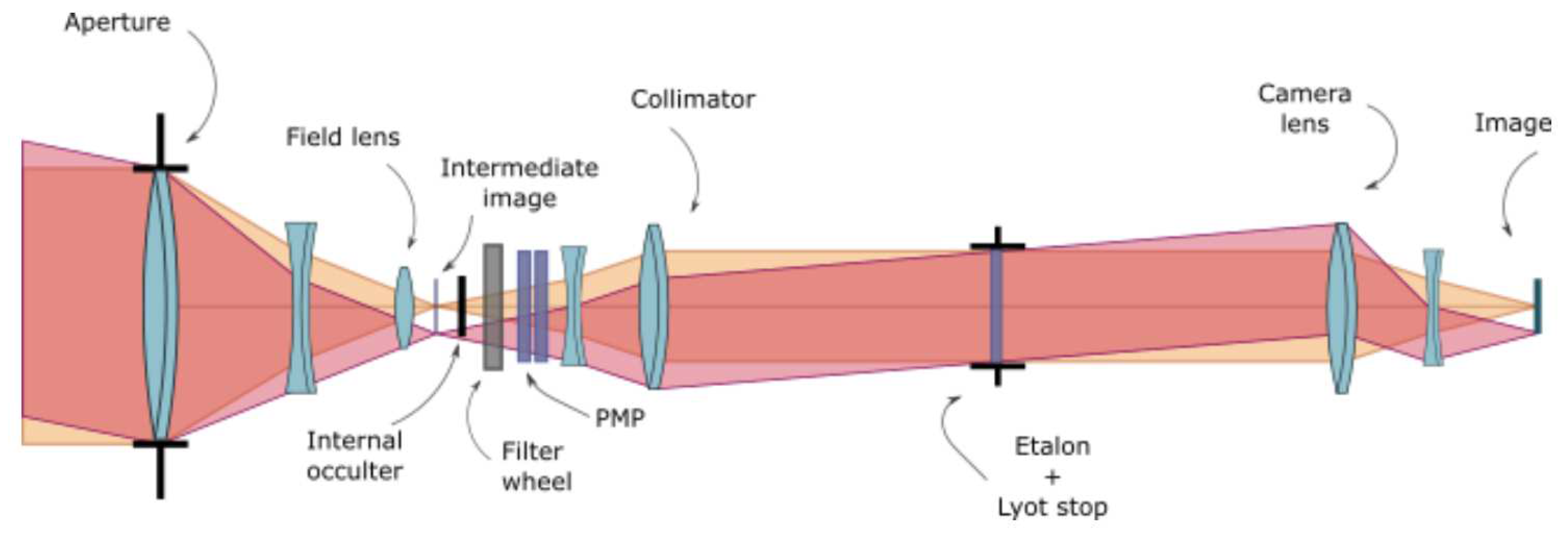
Disclaimer/Publisher’s Note: The statements, opinions and data contained in all publications are solely those of the individual author(s) and contributor(s) and not of MDPI and/or the editor(s). MDPI and/or the editor(s) disclaim responsibility for any injury to people or property resulting from any ideas, methods, instructions or products referred to in the content. |
© 2023 by the authors. Licensee MDPI, Basel, Switzerland. This article is an open access article distributed under the terms and conditions of the Creative Commons Attribution (CC BY) license (http://creativecommons.org/licenses/by/4.0/).





